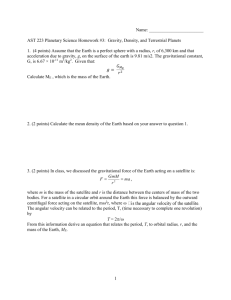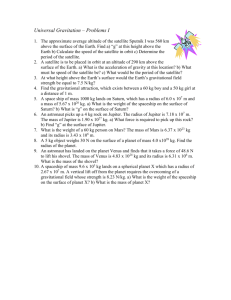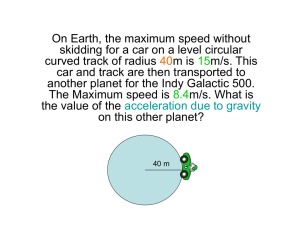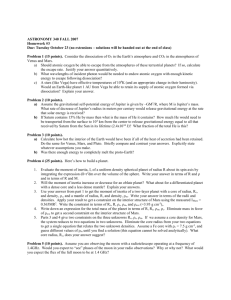Rotary Homework #1:
advertisement
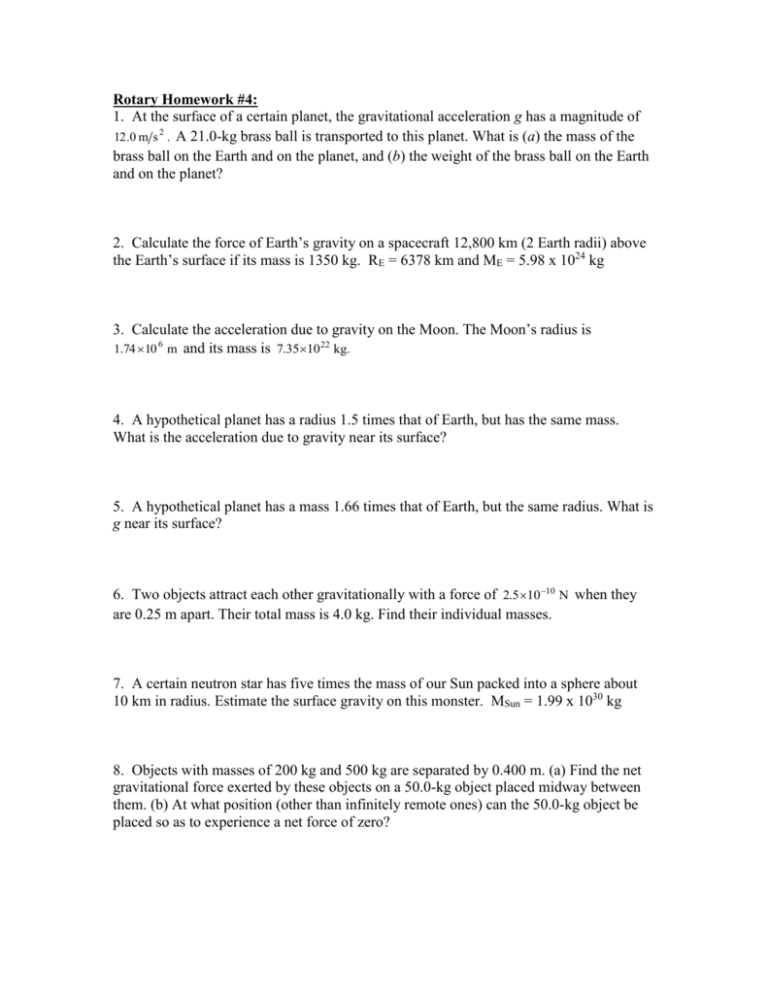
Rotary Homework #4:
1. At the surface of a certain planet, the gravitational acceleration g has a magnitude of
12 .0 m s 2 . A 21.0-kg brass ball is transported to this planet. What is (a) the mass of the
brass ball on the Earth and on the planet, and (b) the weight of the brass ball on the Earth
and on the planet?
2. Calculate the force of Earth’s gravity on a spacecraft 12,800 km (2 Earth radii) above
the Earth’s surface if its mass is 1350 kg. RE = 6378 km and ME = 5.98 x 1024 kg
3. Calculate the acceleration due to gravity on the Moon. The Moon’s radius is
1.74 10 6 m and its mass is 7.3510 22 kg.
4. A hypothetical planet has a radius 1.5 times that of Earth, but has the same mass.
What is the acceleration due to gravity near its surface?
5. A hypothetical planet has a mass 1.66 times that of Earth, but the same radius. What is
g near its surface?
6. Two objects attract each other gravitationally with a force of 2.5 10 10 N when they
are 0.25 m apart. Their total mass is 4.0 kg. Find their individual masses.
7. A certain neutron star has five times the mass of our Sun packed into a sphere about
10 km in radius. Estimate the surface gravity on this monster. MSun = 1.99 x 1030 kg
8. Objects with masses of 200 kg and 500 kg are separated by 0.400 m. (a) Find the net
gravitational force exerted by these objects on a 50.0-kg object placed midway between
them. (b) At what position (other than infinitely remote ones) can the 50.0-kg object be
placed so as to experience a net force of zero?
Rotary Homework #5:
9. A satellite moves in a circular orbit around Earth at a speed of 5,000 m/s. Determine
(a) the satellite’s altitude above the surface of Earth and (b) the period of the satellite’s
orbit. RE = 6378 km and ME = 5.98 x 1024 kg
10. A 600-kg satellite is in a circular orbit about Earth at a height above Earth equal to
Earth’s mean radius. Find (a) the satellite’s orbital speed, (b) the period of its revolution,
and (c) the gravitational force acting on it.
11. Io, a satellite of Jupiter, has an orbital period of 1.77 days and an orbital radius of
4.22 × 105 km. From these data, determine the mass of Jupiter.
12. Neutron stars are extremely dense objects that are formed from the remnants of
supernova explosions. Many rotate very rapidly. Suppose that the mass of a certain
spherical neutron star is twice the mass of the sun and its radius is 10.0 km. Determine
the greatest possible angular speed the neutron star can have so that the matter at its
surface on the equator is just held in orbit by the gravitational force. MS = 1.99 x 1030 kg
13. Assume that you are agile enough to run across a horizontal surface at 8.50 m/s,
independently of the value of the gravitational field. What would be (a) the radius and (b)
the mass of an airless spherical asteroid of uniform density 1.10 × 103 kg/m3 on which
you could launch yourself into orbit by running? (c) What would be your period?
{HINT: Write Kepler’s 3rd Law in terms of the density of the gravitating source rather
than the mass.}
m
4
mv 2 GMm
3
density = D
, volume of a sphere = V R , centripetal force =
V
3
R
R2
Solutions:
1. (a) Mass is independent of location and so the mass of the ball is 21.0 kg on both the Earth
and the
planet.
(b) The weight is found by W mg .
WEarth mg Earth 21.0 kg 9.80 m s 2 206 N
WPlanet mg Planet 21.0 kg 12.0 m s 2 252 N .
2. The spacecraft is three times as far from the Earth’s center as when at the surface of the Earth.
Therefore, since the force as gravity decreases as the square of the distance, the force of
gravity on the spacecraft will be one-ninth of its weight at the Earth’s surface.
1350 kg 9.80 m s 2
1
FG 9 mg Earth's
1.47 103 N
9
surface
3. The force of gravity on an object at the surface of a planet is given by Newton’s law of
Universal
Gravitation, using the mass and radius of the planet. If that is the only force on an object,
then the acceleration of a freely-falling object is acceleration due to gravity.
M m
FG G Moon
mg Moon
2
rMoon
g Moon G
M Moon
2
Moon
r
7.35 10 kg 1.62 m s
1.74 10 m
22
6.67 10
11
N m kg
2
2
6
2
2
4. The acceleration due to gravity at any location on or above the surface of a planet is given by
gplanet G M Planet r 2 , where r is the distance from the center of the planet to the location in
question.
M
M Earth
M Earth
1
1
9.8 m s 2
g planet G Planet
G
G
g
4.4 m s 2
Earth
2
2
2
2
2
2
r
1.5
1.5REarth 1.5 REarth 1.5
5. The acceleration due to gravity at any location at or above the surface of a planet is given by
gplanet G M Planet r 2 , where r is the distance from the center of the planet to the location in
question.
g planet G
M Planet
r
2
G
1.66M Earth
2
Earth
R
M Earth
2
Earth
1.66 G
R
2
2
1.66 g Earth 1.66 9.80 m s 16.3m s
6. Assume that the two objects can be treated as point masses, with m1 m and m2 4 kg m .
The gravitational force between the two masses is given by
m 4 m
mm
4m m 2
11
2
2
F G 12 2 G
6.67
10
N
m
kg
2.5 1010 N .
2
2
r
r
0.25 m
This can be rearranged into a quadratic form of m 2 4m 0.234 0 . Use the quadratic
formula to solve for m, resulting in two values which are the two masses.
m1 3.9 kg , m2 0.1 kg .
7. The acceleration due to gravity at any location at or above the surface of a star is given by
g star G M star r 2 , where r is the distance from the center of the star to the location in
question.
5 1.99 1030 kg
M star
5M Sun
11
2
2
gstar G 2 G 2 6.67 10 N m kg
7 1012 m s 2
2
4
r
r
1 10 m
8. (a) At the midpoint between the two masses, the forces exerted by the 200-kg and
G m1m2
500-kg masses are oppositely directed, and from F
we have
r2
F
G 50.0 kg 500 kg 200 kg
0.200 m
2
2.50 105 N
toward the 500-kg
(b)
At a point between the two masses and distance d from the 500-kg mass,
the net force will be zero when
G 50.0 kg 200 kg
0.400 m
d
2
G 50.0 kg 500 kg
d2
or d 0.245 m
Note that the above equation yields a second solution d 1.09 m . At that point, the two
gravitational forces do have equal magnitudes, but are in the same direction and cannot
add to zero.
9.
(a) The gravitational force must supply the required centripetal acceleration, so
vt2
G mE m
Gm
m
. This reduces to r 2 E , which gives
2
r
r
vt
24
N m 2 5.98 10 kg
r 6.67 1011
1.595 107 m
2
2
kg
5000 m s
The altitude above the surface of the Earth is then
h r R E 1.595 107 m 6.38 106 m 9.57 106 m
(b)
The time required to complete one orbit is
7
circum ference oforbit 2 1.595 10 m
T
2.00 104 s 5.57 h
orbitalspeed
5000 m s
10.
(a) The satellite moves in an orbit of radius r 2R E and the gravitational force
supplies the required centripetal acceleration. Hence,
2R
m vt2 2RE G m E m
vt
2
E
, or
24
G mE
N m 2 5.98 10 kg
6.67 1011
5.59 103 m s
2RE
kg2 2 6.38 106 m
(b) The period of the satellite’s motion is
6
2 r 2 2 6.38 10 m
T
1.43 104 s 3.98 h
vt
5.59 103 m s
The gravitational force acting on the satellite is F G m E m r2 , or
(c)
24
N m 2 5.98 10 kg 600 kg
F 6.67 1011
1.47 103 N
2
6
kg2
2 6.38 10 m
11.
The gravitational force exerted on Io by Jupiter provides the centripetal
v2
GM m
rvt2
,
or
M
r2
G
acceleration, so m t
r
The orbital speed of Io is
vt
2 4.22 108 m
2 r
1.73 104 m s
T
1.
77
days
86400
s
day
4.22 10 m 1.73 10
8
Thus, M
12.
4
11
6.67 10
N m
2
m s
kg
2
2
1.90 1027 kg
The gravitational force on a small parcel of material at the star’s equator supplies
the centripetal acceleration, or
Hence, G M
s
R s3
vt2
G M sm
2
m
R m R s
R s2
s
6.67 10
11
13.
kg2 2 1.99 1030 kg
1.63 104 rad s
3
3
10.0 10 m
N m
2
(a) In order to launch yourself into orbit by running, your running speed must
be such that the gravitational force acting on you exactly equals the force
needed to produce the centripetal acceleration. That is, GM m r2 m vt2 r,
where M is the mass of the asteroid and r is its radius. Since
4
M density volum e r3 , this requirement becomes
3
3vt2
.
4 G
m vt2
4
m
or r
G r3 2
3
r
r
The radius of the asteroid would then be
r
3 8.50 m s
4 6.673 1011 N m
2
2
kg2 1.10 103 kg m
3
1.53 104 m
or r 15.3 km
(b) The mass of the asteroid is given by
4
M r3 1.10 103 kg m
3
(c)
3
43 1.53 10 m
Your period will be
4
2 r 1.53 10 m
T
1.13 104 s
vt
8.50 m s
2
4
3
1.66 1016 kg
